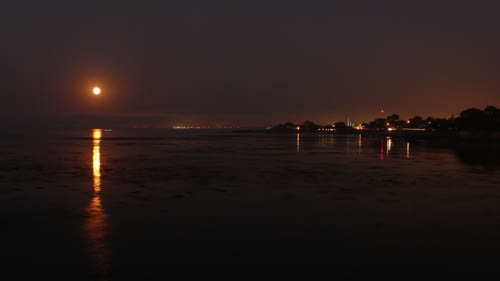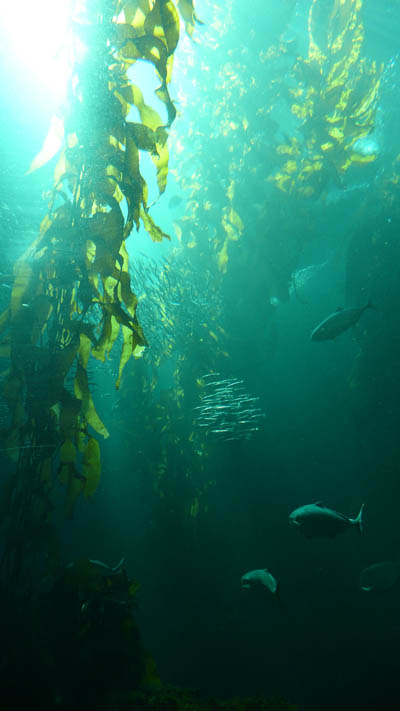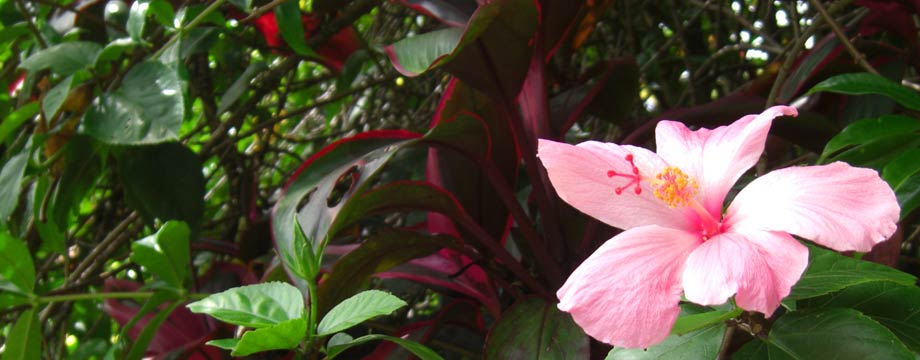Now here’s a funky introduction with some Ghostface, Roots, Gnarls, and more…
Violin and Turntables
Polychaete Worm
This is a polychaete worm that I found on a piece of drift kelp magnified at x50. Little beasties look a lot meaner under the microscope.
It’s nice to have a mini-lab on board when you’re looking at marine organisms.
Inverted Sunflower Star
Pycnopodia helianthoides (AKA Sunflower Star or Sun Starfish) is a nasty customer. This is the T. Rex of the starfish, and can travel a blistering 40 inches per minute to boot.
When you get one of these in a trap, it is imperative to remove them right away, or they will clamp down on whatever it is grabbing onto with up to 24 tube feet-filled arms with such force, it may be unable to extract the animal without ripping off some of the tube feet.
They also have pincers on their top side that are used to discourage potential predators. In addition, they can secrete a mild poison when agitated. In the ocean, it acts as a mild deterrent, but if this stuff is contained in a small tank, it could cause more serious damage to fish or other animals in such a constrained environment.
This is from the MBA Field Guide:
Juvenile sunflower stars start life with five arms—by maturity they sport up to 24 arms.
Most sea stars have a one-piece, semirigid skeleton. However, the sunflower star’s skeleton has a few disconnected pieces. They allow the sunstar’s mouth to open wide and its body to enlarge and take in big prey. A sunflower star can swallow an entire sea urchin, digest it internally and then expel the urchin’s test—its external shell.
In Monterey Bay, the sunflower star eats—in season—dead or dying squid. After the star digests the squid, the indigestible squid pen—its internal shell, which is too large to be defecated—works its way through the body wall.
I know of nothing that likes to eat Pycnopodia helianthoides, and I can see why. Besides the toxins, pincers, and enormous size (they grow over a meter long from tip to tip), they are covered in a viscous slime, much resembling a suit made of snot (it has the texture of grated yama imo).
It might be worth handling, just to give someone a hearty handshake immediately afterwards. I can just picture the look of horror on the hand of the recipient as they quickly withdraw from the shake, with tendrils of mucus stretching and extending like strings of natto linking the tips of a pair of chopsticks to a bed of freshly stirred fermented soy beans. Mmmmmm… Natto.
Full Moon Pictures
Taking pictures in low light settings is challenging for me, but at least the moon stays still. Here are a few shots that I took from the past couple of nights:
This picture was taken yesterday with the D-50.

The moon still looks really full on this shot from today, taken on my DMC-TZ3.
Shark Attack near my apartment!
My sister wanted to bring a surfboard up from Orange County so she could learn how to surf, but she has changed her mind.
I’m going to see if they’ve closed the beach over at Lover’s Point as well. Here’s a link to the article:
Shark attacks surfer in Monterey Bay
*BONUS* – MBA has a new white shark on exhibit. Only 4 feet and change, it kind of looks like a puppy, swimming around the Outer Bay Exhibit with the bubble curtain up.
The Hunters

The Yellowtails are the coolest fish in the Kelp Forest Exhibit. Not only are they my favorite sashimi fish and great fighting on the rod, but they’re also fun to watch under water. They cruise around like a pack of attack submarines, and the bait fish try to keep as far away from them as possible.
Oftentimes, the other fish will use this to their advantage and snag an Anchovy that’s broken formation with the rest of the school and preoccupied with watching the Yellowtail. Many a Rockfish has gotten its lunch in said fashion, thanks to the Yellowtail.
On this day, one of the ‘tails was chasing a Leopard Shark, that was three times it’s size, around the exhibit. It kept on rubbing against the shark, and despite trying its hardest, the shark was unable to run away.
I wonder if it was using the shark as a back scratcher, to dislodge parasites, or asserting its dominance as king of the exhibit. Maybe it was a bit of both.
The most popular fish in the aquarium?
We spotted an object floating in the water, and went to investigate:
From this distance, it is hard to make out. It was about the size of a small garbage can lid.
A naturalist once saw something very similar to this in the kelp forest and got very excited. “White Shark!” was the call heard on the radio, but alas, it was not a White Shark. So what was it?
It was a Mola mola, the awkward Ocean Sunfish, a ferocious predator of jellies, larval animals floating around as plankton, and perhaps seaweed and eel grass.
For some reason, my camera has been drawn towards this largest of bony fishes in different places. I am not the only one who likes the mola- I think it’s the most popular fish in the aquarium. The big mola in the Outer Bay Exhibit, the one that weighs over 1000 pounds, has been given so many names by little children and smitten adults alike. If you were to tally the names, “big fish” would likely be the most common, followed by “ugly fish”. I like to call it “Bob”.
New Camera Day!
I love my Nikon D-50, but ever since I traded in my trusty old battle-scarred QV-R40, I’ve really noticed how handy a pocket-sized camera is. I’ve been waiting to find one that I really liked, and finally settled on the Panasonic DMC-TZ3. Aside from having a Leica lens that boasts 10x optical zoom and virtually no shutter lag, it’s just a really nicely designed camera. I’ll be testing it out for a while, but here are some preliminary pictures from a 5 minute walk around my neighborhood:
A bee pollinates a California poppy, which also happens to be our state flower. Its bright orange is much like that of the Garibaldi, California’s state fish.
A few months ago, Pacific Grove installed these tsunami warning signs along the coastline. I swear I’ve seen a design very similar to this in Japan somewhere.
This barnacle shell has been taken over by seaweed. The shell broke off, the seaweed dried out, and now it is resting on the beach at Lover’s Point.
With this smaller camera, I can be more discrete when taking pictures, I can take it places where the D-50 is impractical, and I can use it to shoot in ways that the D-50 can’t.
With this new camera I’ll be able to shoot using a display, which should be interesting. I find that the style of my photos is a bit different when I use a viewfinder, as opposed to looking at a screen to compose a picture.
It feels good to have more than just an SLR again. I wish every day could be New Camera Day!
Giant Kelp: exploring a corner of the microcosm
A tiny sea urchin rests between closed fingers.
This is a shot of a polychaete worm and the same urchin.
The blurs in the background are (rotating clockwise from the upper top) a shrimp, an isopod, a melibe, a limpet, and some other creatures. In the foreground, there are the urchin, polychaete worm, and a couple of juvinile Kellet’s whelks that are either being amorous or quarrelsome. Their proboscises were extended as they wrestled together in what must have seemed to be the macro-marine equivalent of the Colosseum. No, they did not fight to the death, but if they did my money would be on the worm.
I recall that Justin and I used to use polychaetes as bait when we went fishing in Awajishima for kawahagi and other strange, exotic fish.
The kelp crabs and decorator crabs are really good at hiding, and are not very eager to be photographed. It’s amazing the variety of colors that they display, from lemon yellow to grass green to brick red.
California Sea Lions and other noisy marine animals
Peace and quiet have once again departed from the harbor, with the return of the California Sea Lions. Adding to the cacophony, the Sea Otters have been shrieking like banshees lately. To top it off, the gulls consistently wake me up in the morning with their vocalizations, and follow me to work with their squabbles.
There is something to be said for peace and quiet, especially in the morning when you are trying to sleep.
Sometimes, when the gulls are particularly loud and persistent, I come up with some interesting ideas. For example, I may develop an urge to hold onto the extreme annoyance that is conjured up by the squawking birds, and use it to wake up the gulls when they are trying to sleep. It is only after I am fully awake that I realize how stupid it would be to actually act on the ideas that pop into my head when I’m irritated in this too-early-in-the-morning state.
If I live long enough to develop Alzheimer’s disease, will I become the crazy old man who goes out at night blasting away on the drums, exacting my revenge upon the birds? Now that’s a scary thought…

